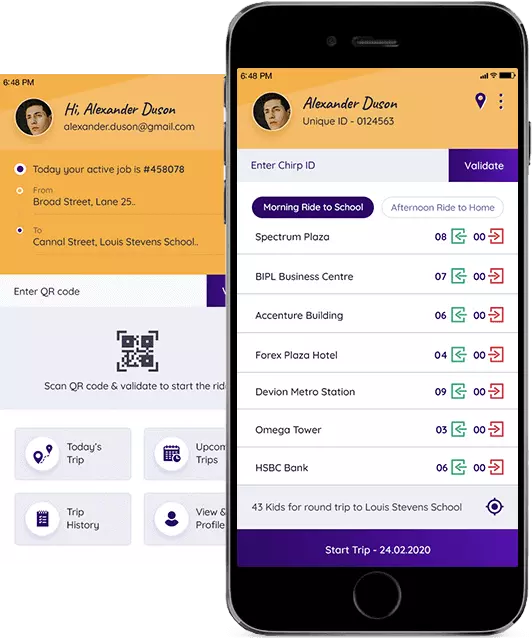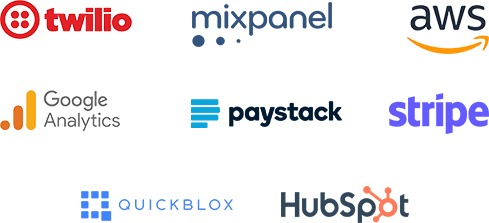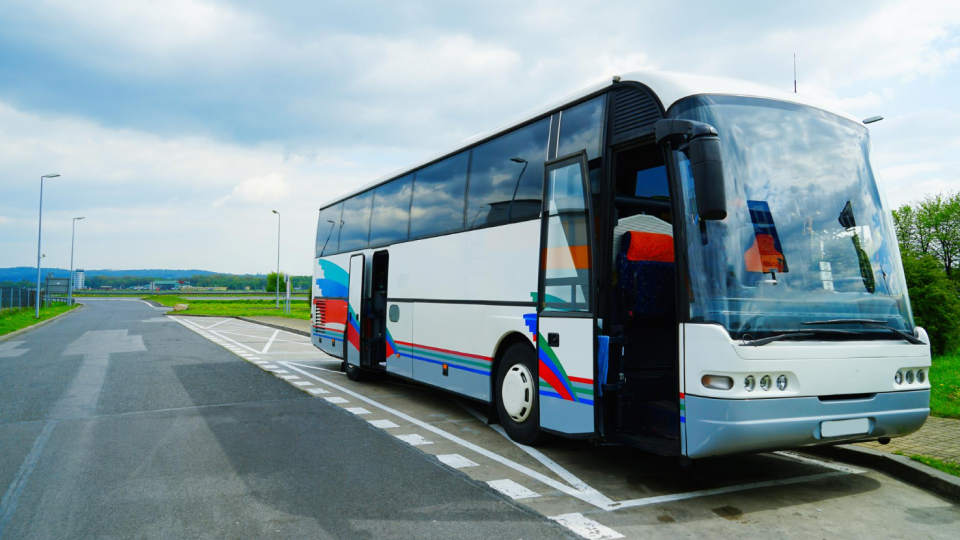Smart School Transportation Solution With Tracking Features
AllRide's school bus transportation solution uses innovative technology to connect parents, drivers, and school admins by leveraging mobile convenience. We help you upgrade the school bus system by deploying technologies like AI-driven advanced fleet management and UX strategy with interaction principles that have worked for more than 70 transport businesses.

Features Our School Bus Software Offers
Seamless Parent Portal
Get access to a user-friendly parent portal that provides bus schedules, routes, and real-time tracking information, allowing parents to plan and monitor their child's transportation to and from school.
Attendance Tracking
Track student attendance on buses, maintaining accurate records for accountability and ensuring that no students are left behind or misplaced during transit
Efficient Route Planning
We provide bus routes based on factors like student addresses, traffic patterns, and road conditions, reducing travel time and fuel costs
Reporting & Analytics
Generate insights into bus fleet utilization, on-time performance, fuel consumption, and other key metrics facilitating data-driven decision-making and continuous improvement
Integration Capabilities
Ensure a hassle-free booking experience with a secure & convenient online payment processing
Hassle-Free Driver Management
Leverage from AI-powered driver management features, including scheduling, training, tracking, performance monitoring, and compliance with regulations, such as driver hours and certifications
Centralized Student Information
Track student demographics, eligibility for transportation services, and contact details for emergency purposes
Robust Communication Tools
Integrate communication tools for instant alerts and notifications to parents, drivers, & administrators for route changes, delays, emergencies, or other crucial information
GPS Tracking
Enable administrators and parents to monitor bus locations, ensuring timely arrivals and departures, and enhancing safety

Efficient School Bus Routing
Our school bus routing software facilitates efficient route planning by optimizing bus schedules and routes based on factors such as student population density, traffic patterns, and road conditions. By automating the route planning process, schools can:
- Minimize travel time
- Reduce fuel consumption
- Ensure timely pickups and drop-offs for students
Better School Bus Fleet Management
Our school bus fleet management software improves fleet operations and connects schools, transportation departments, drivers, and parents. Administrators are allowed to automate vehicle maintenance schedules to improve fleet longevity.


Advanced School Bus Tracking
We have come up with a bus tracking software solution that monitors & manages school transportation systems. It includes:
- Real-time GPS, student, & driver tracking
- Route Optimization
- Notifications
- Student tracking
- Geofencing
- Historical data
Data-driven Business Decisions
School bus transportation software generates valuable data and analytics that enable informed decision making and continuous improvement efforts. By analyzing route performance, on-time arrivals, and other key metrics, schools can identify trends, areas for improvement, and potential cost-saving opportunities.

Trusted By 1,000+ Businesses Worldwide


Why Should You Choose AllRide For School Transport Solution?
AllRide Bus offers a ready-to-launch school bus software to enable schools to provide a safe and convenient transportation system. Our school bus fleet management software provides:
- AI-based optimization
- 100+integrations
- Real-time updates
- Customization & flexibility
- Multi-platform accessibility
- 50+ language support
Our Partners
School Bus Transportation Software FAQs
- System Setup and Configuration
- Choose a reputable school transport management software provider and subscribe to their service. Configure the software according to your school's specific needs, including adding information about bus fleets, drivers, routes, and student data.Set up user accounts and permissions for administrators, transportation staff, drivers, and parents.
- Data Input and Maintenance
- Input relevant data into the system, such as student information (including addresses, bus stops, and eligibility for transportation services), bus schedules, route details, driver details, and vehicle information. Regularly update and maintain the data to ensure accuracy and relevance, especially as student enrollment changes or new transportation routes are added.
- Route Planning and Optimization
- Utilize the software's route planning and optimization features to create efficient bus routes based on factors such as student population density, pickup/drop-off locations, traffic patterns, and timing constraints. Adjust routes as needed to accommodate changes in student enrollment, road conditions, or scheduling requirements.
- Communication and Notifications
- Use the software's communication tools to send important announcements, alerts, and notifications to parents, drivers, and staff members. Inform parents about bus schedules, route changes, delays, or emergencies in real-time via email, SMS, or mobile app notifications.
- Real-time Tracking and Monitoring
- Monitor the real-time location of school buses using GPS tracking technology integrated into the software. Track bus movements, arrivals, and departures to ensure adherence to schedules and identify any deviations or delays.
- Safety and Compliance Management
- Implement safety protocols and compliance measures within the software to ensure that drivers adhere to safety regulations and operational standards. Monitor driver behavior, vehicle maintenance schedules, and compliance with safety procedures to mitigate risks and ensure the safety of students and staff.
- Reporting and Analysis
- Generate reports and analytics using the software's reporting tools to evaluate transportation performance, analyze key metrics (such as on-time arrivals, route efficiency, and fuel consumption), and identify areas for improvement. Use data-driven insights to make informed decisions about route optimization, resource allocation, and operational enhancements.
- Training and Support
- Provide training and support to administrators, transportation staff, drivers, and parents on how to use the software effectively. Offer technical assistance and troubleshooting support to address any issues or concerns that arise during software implementation and usage.
- A. System Setup and Configuration:
- Choose a reputable school transport management software provider and subscribe to their service. Configure the software according to your school's specific needs, including adding information about bus fleets, drivers, routes, and student data.Set up user accounts and permissions for administrators, transportation staff, drivers, and parents.
- B. Data Input and Maintenance:
- Input relevant data into the system, such as student information (including addresses, bus stops, and eligibility for transportation services), bus schedules, route details, driver details, and vehicle information. Regularly update and maintain the data to ensure accuracy and relevance, especially as student enrollment changes or new transportation routes are added.
- C. Route Planning and Optimization:
- Utilize the software's route planning and optimization features to create efficient bus routes based on factors such as student population density, pickup/drop-off locations, traffic patterns, and timing constraints. Adjust routes as needed to accommodate changes in student enrollment, road conditions, or scheduling requirements.
- D. Communication and Notifications:
- Use the software's communication tools to send important announcements, alerts, and notifications to parents, drivers, and staff members. Inform parents about bus schedules, route changes, delays, or emergencies in real-time via email, SMS, or mobile app notifications.
- E. Real-time Tracking and Monitoring:
- Monitor the real-time location of school buses using GPS tracking technology integrated into the software. Track bus movements, arrivals, and departures to ensure adherence to schedules and identify any deviations or delays.
- F. Safety and Compliance Management:
- Implement safety protocols and compliance measures within the software to ensure that drivers adhere to safety regulations and operational standards. Monitor driver behavior, vehicle maintenance schedules, and compliance with safety procedures to mitigate risks and ensure the safety of students and staff.
- G. Reporting and Analysis:
- Generate reports and analytics using the software's reporting tools to evaluate transportation performance, analyze key metrics (such as on-time arrivals, route efficiency, and fuel consumption), and identify areas for improvement. Use data-driven insights to make informed decisions about route optimization, resource allocation, and operational enhancements.
- H. Training and Support:
- Provide training and support to administrators, transportation staff, drivers, and parents on how to use the software effectively. Offer technical assistance and troubleshooting support to address any issues or concerns that arise during software implementation and usage.
Team Up With AllRide To Provide Better School Transportation Services!




































